What does it take to build a monument, a lasting legacy, to the First Landing of the Pilgrims in Provincetown? Determination and persistence and, of course, money, not to mention years of territorial squabbles and skirmishes. Finally dedicated in 1910, Provincetown’s Pilgrim Monument has a story that may be said to have begun ninety years earlier across the bay in Plymouth.
 Pilgrim Hall, Plymouth, ca. 1860. Stereograph, courtesy Library of Congress, Prints & Photographs Division
Pilgrim Hall, Plymouth, ca. 1860. Stereograph, courtesy Library of Congress, Prints & Photographs Division
With its roots in the Old Colony Club, founded in 1769, the Pilgrim Society was formally organized in Plymouth in 1820, the bicentennial of the Landing of the Pilgrims. Its mission was to perpetuate the memory of the Mayflower Pilgrims, specifically with the goal of building appropriate monuments, the first of which was Pilgrim Hall, whose cornerstone was laid in September 1824.[1] It would be another three decades before the Pilgrim Society would vote, in May 1850, to build a monument upon or near the rock where the Pilgrims had landed. The idea was met with such popular interest that not only would a modest monument be built to protect Plymouth Rock, but a larger memorial – grand and inspiring – would rise in a prominent place to commemorate the struggles and triumphs of the Mayflower Pilgrims.
On 2 August 1859, the cornerstones for both monuments were laid with Masonic and religious ceremonies, and in 1867 the Victorian canopy covering Plymouth Rock designed by artist and architect Charles Howland Hammatt Billings (1818-1874) was completed.[2] It was not until 1 August 1889 that Plymouth’s second monument, the Pilgrim Monument – now known as the National Monument to the Forefathers – was dedicated atop Monument Hill (Allerton Street). From this summit, every place important to the Pilgrims – Provincetown, Clark’s Island, Kingston, Duxbury, and Marshfield – could be seen. Also designed by Billings, the all-granite colossus depicts a soaring figure of Faith from whose pedestal project statues representing Morality, Education, Freedom, and Law.
It was, no doubt, the monumental enthusiasm for the Pilgrims’ legacy awakened in Plymouth that inspired a group of Cape Cod citizens and descendants in May 1851 to organize the Cape Cod Association, whose mission was to promote Provincetown as the site of the First Landing of the Pilgrims.
It was, no doubt, the monumental enthusiasm for the Pilgrims’ legacy awakened in Plymouth that inspired a group of Cape Cod citizens and descendants in May 1851 to organize the Cape Cod Association, whose mission was to promote Provincetown as the site of the First Landing of the Pilgrims. In February 1852, a motion was made in the Massachusetts Legislature to consider the expediency of funding a monument atop High Pole Hill, the highest elevation in Provincetown.
The Barnstable Patriot proclaimed: “Towering to the heavens, it will be the last American object that shall meet the eye of the Massachusetts mariner as he departs for those remote and various regions to which he is conducted by enterprise and daring, reminding him of the early history of his native land, and reinforcing the ordinary motives that he is governed by to do nothing unworthy of that land. Returning, it will be the first object that shall greet his sight, the first palpable evidence that he has reached that home to the comforts and manifold endearments of which he is, in common with all his fellow citizens, so largely indebted to the heroical labors of the men whose honor the column has been raised. It would be seen far over those waters along which the Mayflower made her adventurous passage, and would be, as it were, a bond of connection between that age of iron and the golden age that has grown out of it.”
On 11 August 1852, the Association celebrated its second anniversary with a gala, star-studded event at Provincetown. The streets were profusely and gaily decorated, triumphal arches were erected throughout the town, one adorned with special mottoes in honor of invited guest Daniel Webster, though important duties kept him in Washington. Banners, flags, streamers, and wreaths bedecked hotels, churches, and wharves, bells pealed, and artillery boomed. A special pavilion – to add “greater éclat to the celebration” – was pitched and arranged with tables to accommodate 2,000 guests. James Gifford, on behalf of the citizens of Provincetown, welcomed members and guests with a brief speech, reminding them of the “ancient glory of their fathers; of their toil and sufferings, of their virtues, of their glorious immortality, and he implored them to never forget with what a price their prosperity, happiness and liberties had been purchased.”[3]
Cape Cod Association president Chief Justice Lemuel Shaw (1781-1861), the Barnstable-born son of the Rev. Oakes Shaw, spoke to the “exalted character of the settlers of Cape Cod, who fearing God, knew no other fear. This animated their hopes and sustained their courage. But it is not alone the Pilgrims of the Mayflower whom we must bear high in our regard on this occasion. It is the pilgrim mothers to whom we owe so much Cape Cod glory. All honor to those noble women.”[4]
It was not long before lively debate – some called it a controversy – ensued between the citizens of Plymouth and Provincetown as to which place was more entitled to a monument commemorating the Landing. (A later Boston Globe story, in revisiting the early efforts, went so far as to claim that Plymouth had prevented the passage of the 1852 legislation “though a jealous desire to retain a monopoly of Pilgrim traditions.”) In September 1857, J.W. Emery, the editor of the Provincetown Banner, fired off a letter to the editors of the New York Evening Post, the “influential journal” that he hoped would dispel the “popular delusion that Plymouth was the first Landing-place of the Pilgrims,” writing that “If the design be to commemorate the spot where the Pilgrims ‘landed,’ then Provincetown, on the end of Cape Cod, is entitled to the honor of the site of the Monument.” He concluded by writing that “if it be erected at Plymouth it will only perpetuate a lie.”
The so-called “civil war” between Plymouth and Provincetown delayed plans for monuments in both towns...
The response to Emery was equally direct: “No one is ignorant of the facts which he states; but with what propriety can the temporary anchorage of the Mayflower at the end of Cape Cod, during the few days that their exploring party were ‘prospecting along the shore’ to find a suitable place to disembark and settle, be considered as the landing of the Pilgrims in this country?” The editors concluded that to dispute with Plymouth the “honor of being the Landing Place of the Pilgrims – the spot forever sacred, as that on which, abandoning their home upon the deep, they first rested from their wanderings, and planted themselves upon the shores of the new world – would be preposterous in the extreme.”
The so-called “civil war” between Plymouth and Provincetown delayed plans for monuments in both towns, though, as previously noted, Plymouth finally laid cornerstones in 1859. For the near future, plans to build a monument at Provincetown were put on hold … but not forgotten.
By June 1853, High Pole Hill, purchased by the Town of Provincetown from several co-owners, was undergoing changes – levelling and the construction of two roadways – in preparation for the building of a new Town House that included accommodations for the high school. Described as two-and-one-half stories tall, forty-two feet wide and sixty-eight feet long, its style and finish – ionic columns and a clock tower – were to excel any other building in town. Through the efforts of Chief Justice Lemuel Shaw, upon completion of the Town House a white marble tablet was prominently displayed over the front entrance. It was inscribed: In commemoration of the arrival of the “May Flower” in Cape Cod Harbor, and of the first arrival of the Pilgrims in America at this place, November 11, 1620, this tablet is presented by the Cape Cod Association, Nov. 11, 1853.
For a generation the Town House stood as a beacon atop High Pole Hill until, on the evening of 16 February 1877, fire swept through the building, destroying the structure, the marble tablet, and many of the Provincetown’s earliest town records. As devastating as the conflagration was, it gave new impetus to the efforts by members of the Cape Cod Association to build a monument at Provincetown. At the Association’s annual meeting in November 1877, Major Sylvanus Bourne Phinney (1808-1899), a prominent Barnstable-born businessman, civic leader, and founder of the Barnstable Patriot (1830), made a motion that a committee of three be appointed to consider the feasibility of erecting a suitable monument on High Pole Hill to commemorate the First Landing of the Pilgrims.
The Barnstable Patriot reported that “Major Phinney said that Plymouth had enjoyed the honor and glory of being the landing place of the Pilgrims long enough, and since the burning of the Town House in Provincetown and the destruction of the marble slab placed there through the exertions of Chief Justice Shaw nothing was left to commemorate the event.” Though designs and architectural plans were prepared, and cost estimates were submitted for a seventy-foot shaft with a lighted clock and a storm signal station, without the necessary funding the Pilgrim monument project stalled, even as ground was broken in August 1879 for a storm signal station. Yet another delay … but still the Pilgrim Monument was not forgotten.
Concluded here.
Notes
[1] The original building has since had numerous additions and renovations. It is the oldest public museum in continuous operation in the United States.
[2] The canopy was replaced with a pavilion for the Pilgrim tercentenary.
[3] Boston Evening Herald, Thursday, 12 August 1852.
[4] Ibid.
Share this:

About Amy Whorf McGuiggan
Amy Whorf McGuiggan recently published Finding Emma: My Search For the Family My Grandfather Never Knew; she is also the author of My Provincetown: Memories of a Cape Cod Childhood; Christmas in New England; and Take Me Out to the Ball Game: The Story of the Sensational Baseball Song. Past projects have included curating, researching, and writing the exhibition Forgotten Port: Provincetown’s Whaling Heritage (for the Pilgrim Monument and Provincetown Museum) and Albert Edel: Moments in Time, Pictures of Place (for the Provincetown Art Association and Museum).View all posts by Amy Whorf McGuiggan →


